Free-space Data-carrying Bendable Light Communications
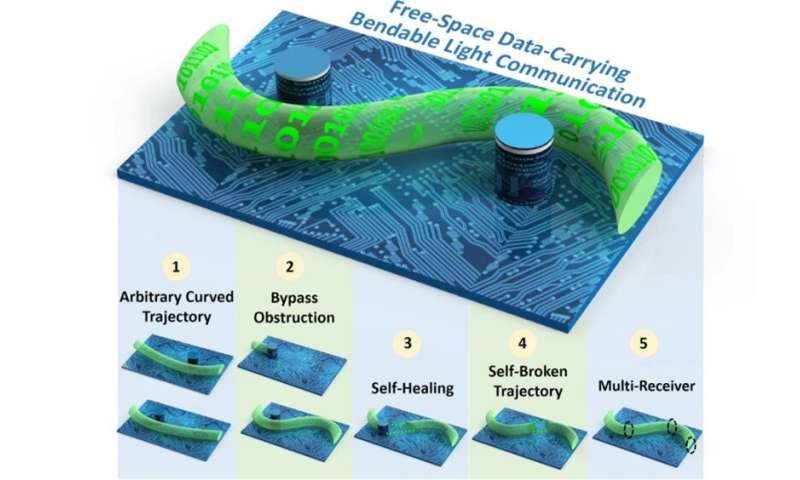
Concept and principle of free-space data-carrying bendable light communications. Credit: Scientific Reports, doi: 10.1038/s41598-019-51496-z
Bendable light beams have significant applications in optical manipulation, optical imaging, routing, micromachining and nonlinear optics. Researchers have long explored curved light beams in place of traditional Gaussian beams for line-of-sight light communications. In a recent study now published on Scientific Reports, Long Zhu and a team of researchers in Optical and Electronic information, in China, proposed and developed free-space, data-carrying bendable light communication systems between arbitrary targets for potential multifunctionality. The researchers employed a 32-ary quadrature amplitude modulation (32-QAM) based discrete multitone (DMT) signal to demonstrate free-space bendable light intensity modulated direct detection (IM-DD) communication in the presence of three curved light paths. They characterized (tested) multiple functions of free-space bendable light communication to reveal that they allowed optical communications to be more flexible, robust and multifunctional. The work will open a new direction to explore special light beams enabled, advanced free-space light communications.
Bendable light beams are a new class of electromagnetic waves associated with a localized intensity maximum that can propagate along a curved trajectory. Researchers have previously studied and reported generic classes of bendable light beams that travel along elliptical and parabolic trajectories. Airy beams (appear to curve as they travel) are a type of non-diffracting beams that maintain its wavefront during transmission, much like Bessel beams (which only exist in theory, ideally) for optical communication free of obstructions. Airy beams possess properties of self-acceleration, non-diffraction and self-healing to propagate along a parabolic trajectory. Aside from airy beams, bendable light beams can reconstruct their wavefront to propagate continuously along the preset trajectory. To explore advantages of bendable light beams for diverse applications, researchers must bend the light along arbitrary trajectories; which can be achieved using the caustic method. The desired trajectory can be achieved with an optical light caustic to implement in real space and in Fourier space.
Physicists had previously used airy beams for free-space information transferwithout exploring additional functionalities of bendable light beams. In the present work, Zhu et al. therefore studied bendable light beams for free-space optical communication. The optical path is traditionally a straight line that connects the transmitter and receiver, however, obstructions between them develop as communication failure. The use of curved light beams during free-space optical communication therefore allow scientists to easily navigate around obstructions using appropriate trajectories. Since bendable light beams are non-diffracting, they can construct their wavefront and continue to propagate along preset trajectories. As a result, scientists can design specific trajectories to send information to multiple users while avoiding unwanted users to build more flexible and robust communication systems.
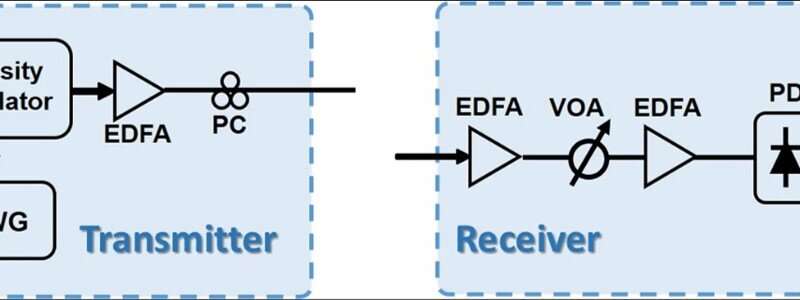
Zhu et al. used phase only spatial light modulation to realize bendable light beams along arbitrary trajectories, including self-broken trajectories. They successfully demonstrated free-space bendable light intensity modulated direct detection (IM-DD) communication systems using three different curved light paths. The research team then categorized the transmission performance within four different conditions:
- Communication bypasses obstructions
- Self-healing communication
- Self-broken trajectory communication
- Movable, multi-receiver communication
The researchers first designed a specific phase pattern for spatial light control using an optical light caustic method to build arbitrarily curved light paths for increased flexibility within the communication system. In contrast to traditional Gaussian beams, the bendable light generated by Zhu et al. bypassed existing obstructions—as expected. The self-healing property of the curved beam made the communication system more robust. They then constructed a self-broken trajectory curved light beam to increase the security of the communication system for the resulting curved light information to be delivered to multiple users along the path of light. The bendable-light, free-space communication system was multifunctional, flexible and robust.
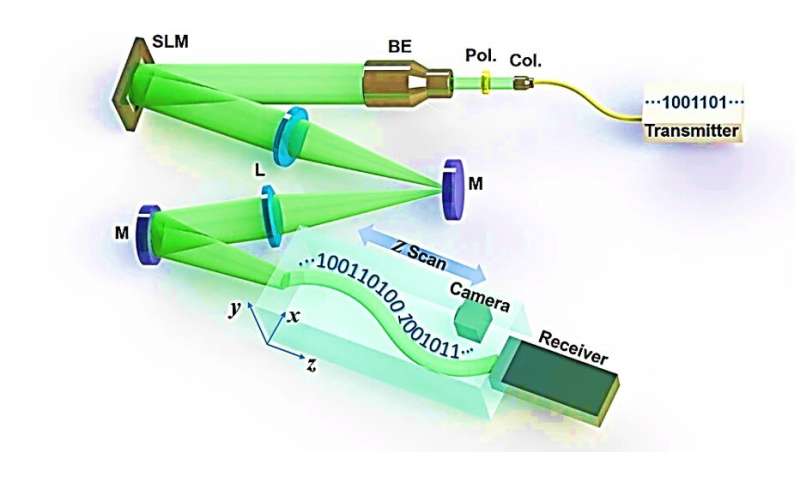
As proof-of-concept, Zhu et al. used a 39.06 Gbit/s, 32-QAM DMT signal transmission at 1550 nm sent to the collimator to generate a free-space Gaussian beam with a two-μm beam diameter and numerical aperture of 0.24. The research team generated the data-carrying bendable light immediately after light polarization alignment using a spatial light modulator (SLM) loaded with the desired phase pattern via the optical light caustic method. The scientists employed a two-lens 4-f imaging system to record the full propagating trajectory and placed a camera to record the dynamics of the propagating bendable curved light moving along a motorized linear translation stage to couple into the receiver for signal detection.
Zhu et al. successfully generated three bendable light beams with different curved trajectories. They first achieved curved light beams along parabolic trajectories and S-shaped curved light beams and observed the measured intensity distributions to be in good agreement with the pre-designed trajectories. The team measured the bit error rate (BER) performance relative to the received optical signal-to-noise ratio (OSNR) for the three bendable light beams. They showed multiple functionalities of free-space bendable light communication.
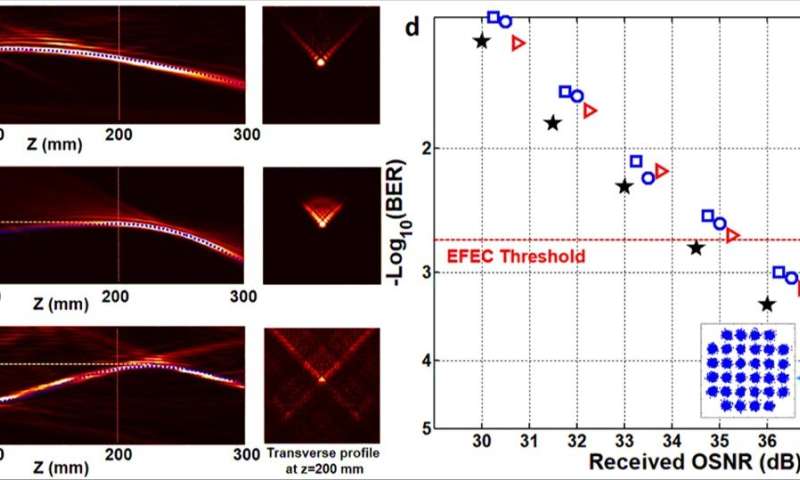
To achieve this, they first set obstructions along the line of sight between the transmitter and receiver and used a Gaussian beam for comparison in the experiments. Zhu et al. set one obstruction (Ob1) and measured BER performance of the S-shaped light beam followed by two obstructions (Ob1 and Ob2), to measure the BER curve of the S-shaped light beam (curve BP-Ob-2). The researchers then showed the self-healing property of free-space bendable light communications using an obstruction of 0.8-mm diameter to block the curved path of an S-shaped bendable beam. After propagation, the light reconstructed its wavefront to reach a receiver 300 mm away as self-healing, data-carrying bendable light. Upon measurement, the performance of the reconstructed light appeared similar to the non-blocked curve. When the team generated a curved light beam with a self-broken trajectory, the main lobe of the curved light appeared to be missing and recovered towards completion of communication. While they could not detect information at the broken part, the scientists successfully received the information at the end of the bendable light beam.
The research team then tested communication performance of the bendable light beam for additional users. Due to its self-healing property, the curved light could deliver information to multiple users along the curved light path trajectory, unlike traditional free-space light communications. The team set three receivers along the light path and measured their BER performance to demonstrate almost similar transmission performance among the three receivers.
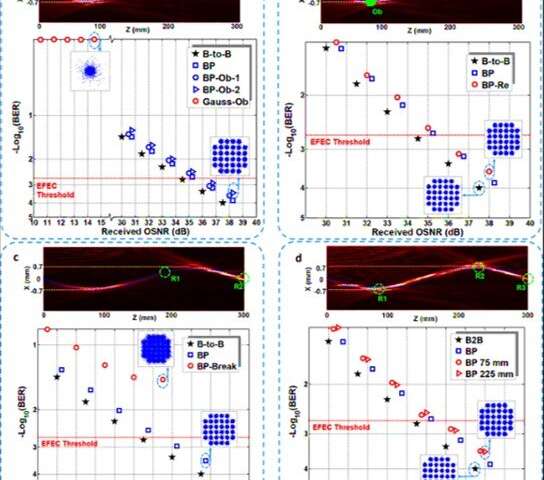
In this way, Long Zhu and colleagues successfully demonstrated free-space, data-carrying bendable light communications and categorized multiple functionalities. The observed results showed that bendable light could deliver dynamic, flexible and robust free-space optical communications. The scientists expect the scheme to be scalable for propagation distance and bending offset. The work will open a new door to explore similar light beams and facilitate extensive free-space light communication systems with advanced versatility.
(From:https://phys.org/news/2019-10-free-space-data-carrying-bendable.html)
